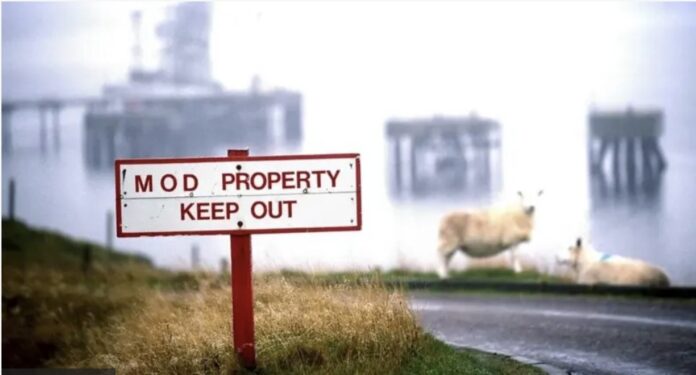In the 1960s, the BBC began to reveal the mysterious practices that took place on the deserted island of the perennial near the Scotland coast during the Second World War. The island was called "Death Island", and its secret affected the imagination not only of local residents but also by journalists.
"This island is deservedly considered a place that hides many mysteries and secrets," said BBC correspondent, Father Robertson, telling about his visit to the island of Hrinard in 1962.
"This story is not about old dark legends or mountain myths. It began in 1942, among the depths of the war. A group of scientists from the military department came to the island and started a series of experiments - so confidential that today, after 20 years, few people know what was happening there."
Robertson resigned to rumors about secret government experiments, which apparently took place on a pearl. However, when he decided to investigate the case, the British Ministry of Defense has already declared the island closed, and the locals refused to carry a journalist on a boat around the island for fear.
For many years, pearls remained a forbidden area due to high pollution, and only in the 1990s was declared safe for visiting. However, the details of the events became known only in 1997, when the government opened a movie filmed by military, which opened the experiments.
It turned out that during the Second World War, British scientists tried to develop biological weapons using anthrax - a deadly bacterial infection. The project, which was called "Vegetarian Operation" was launched under the direction of Paul Filda, the head of the Biological Department of the Porton Down Military Object in Wiltshire, England.
The plan envisaged infection of linen poppy spores of anthrax and throwing them with planes at pastures for livestock in Germany. Cows that would consume these cakes would also be infected with anthrax, which threatened with people who consumed meat.
Siberian ulcer is a deadly infection with delayed symptoms, but when they manifest themselves, they can lead to death. This plan could lead to mass infection in Germany and a huge number of deaths.
To check how anthrax can act as a weapon in real conditions, scientists needed a remote deserted island where they could conduct experiments. In the summer of 1942, the military bought the island of Hrinard, and there began horrific experiments.
"The goal was to check the stability of anthrax in the field - we did not know it - and its ability to remain dangerous," said Edward Spins, Honorary Professor of the University of Lids, in the documentary of the Air Force "The Mystery of the Island of Siberian ulcer" in 2022.
During the experiments, the military released spores of anthrax on the island, observing their spread. The results were horrible: sheep, which were experimental objects, began to show symptoms and die quickly.
Witnesses of these experiments, including local farmers, noticed a cloud of anthrax over the island. One of them mentioned that he saw "smoke that dropped on animals."
The experiments lasted until 1943, when they were recognized as successful. However, infected cakes have not been used because of the successful invasion of allies into Normandy. Britain ceased its chemical and biological weapons programs in 1952 and ratified the Convention on Biological Weapons in 1975.
The consequences of the "vegetarian operation" were destructive to the island. Siberian ulcer is a persistent bacterium that can experience decades in the soil, causing infection even many years after the outbreak. Military experiments made the island a life -threatening people and animals, as well as rainwater that washed away from the island, became potentially deadly.
Within a few months after experiments, the animal on the mainland near the Gulf of Hrinard began to die massively. According to Elizabeth Willis, in his article "Infection and compensation", the Britain's government secretly paid compensation to the victims, but explained the death of a disease of the sheep, which, he said, fell from a Greek vessel, which took place nearby.
In 1962, one local resident stated the BBC: "It was obvious to us that they were hiding something, otherwise they would not pay compensation so quickly."
The military closed the island indefinitely and installed warning signs that forbade it to approach.
Over the end of World War II, attempts were made to decontaminate the island through chemical treatments and controlled combustion, but they were ineffective. A series of tests in 1971 showed that although the spores of anthrax were no longer found on the surface, they are still present in the soil, which poses a serious threat to anyone who steps on the island.
In 1981, an ecological group, called Dark Harvest Commandos, landed on the island and took the soil samples, which was infected with anthrax. They left a bucket with a sample of Earth near Porton Down to draw attention to dangerous contamination on the island and force the government to act.
Five years later, scientists tried to disinfect again using a formaldehyde solution and removing the contaminated topsoil. This time, their efforts were more successful, and finally, on April 24, 1990, after 48 years of quarantine, the UK government declared the island of a perennial free from anthrax.
The island of Hrinard was not the only place where the United Kingdom conducted secret tests of biological weapons, but it became the first. The consequences of these experiments are a confirmation of the danger of biological war and humanity's ability to destroy.


